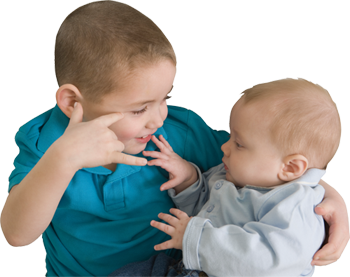

Chapter 1. Language Acquisition in Young Children
Synopsis

Language Acquisition in Young Children
Author
Pauline Davey Zeece, University of Nebraska – Lincoln

Synopsis
In this activity, the science and scientific methods related to the study of human development are explored in the context of children’s language acquisition and the nature/nurture controversy. Video clips highlight a new sign language created by deaf Nicaraguan children (Nicaraguan Sign Language) and provide insights into how language evolves.
REFERENCES
Chomsky, N. (1986) Knowledge of Language: Its Nature, Origin and Use. New York: Praeger.
Clark, E.V. (2003) First Language Acquisition. Cambridge: Cambridge University Press.
Lerner, R. (2006). Developmental science, developmental systems, and contemporary theories of human development. In W. Damon & R. Lerner (Eds.) Handbook of Child Psychology Volume 1: Theoretical Methods of Human Development. New York: Wiley.
Lust, B., & Foley, C. (Eds.) (2004). First Language Acquisition: The Essential Readings. New York: Wiley.
Salkie, R. (1990). The Chomsky Update. London: Routledge.
Senghas, A., Kita, S., & Ozyurek, A. (2004). Children creating core properties of language: Evidence from an emerging sign language in Nicaragua, Science, 305, 1779.
Skinner, B.F. (1957) Verbal Behavior. New York: Appleton-Century-Crofts, New York.
The Science of Human Development

Take a minute to think about some of the ways in which you are the same today as when you were two years old. Now, consider how you have changed since that age. How would you explain how you have or have not changed since you were a toddler?
The science of human development seeks to understand how and why people (all kinds of people, everywhere) change or remain the same over time. The scientific study of human development, including that of children and adolescents, is based on empirical evidence rather than on theory. Any view of human development is inherently influenced by subjective perceptions because the study of human development is humans studying other humans! Scientific research attempts to parse subjective opinions and empirical findings (Lerner, 2006).
Research and the Scientific Method

To attempt to deal with the distortions of personal opinions and biases, researchers rely on the scientific method, a technique for answering questions that requires empirical research and data-based conclusions. The scientific method includes four steps:
1. Ask a question.
2. Develop a hypothesis, which is a specific prediction to be tested.
3. Test the hypothesis to provide empirical evidence about the validity or falsehood of the hypothesis.
4. Draw conclusions to support or refute the hypothesis.
The Nature/Nurture Debate
Many of the research questions presented by those who study children and adolescents are inspired by or nested within developmental theories. These theories connect facts and observations with patterns and explanations. They guide hypotheses, generate discoveries, and often provide the basis of practice guidance.
Video1
Video2
At the heart of many developmental theories is the nature versus nurture controversy that focuses on whether heredity (nature) or the environment (nurture) has a greater influence on a particular feature of development. The view has swung back and forth over time regarding the amount of influence that either nature or nurture has on a wide range of developmental traits. Today, it is commonly accepted that most aspects of a child’s or adolescent’s development are products of the interaction of both nurture and nature. Advocates of each side of this question introduce theories for how either nature or nurture impacts development (Clark, 2003). Consider how these different advocates would explain children’s language acquisition, which is the process by which language capacity develops in a child.
As an introduction to the topic of language acquisition, play the two videos on this screen.
Language Acquisition: A Nurture View

A major proponent of the position that language acquisition depends largely on environment (nurture) was the behaviorist B. F. Skinner, who theorized that language is acquired through principles of conditioning, including association, imitation, and reinforcement (Skinner, 1957). According to this view, children learn words by associating sounds with objects, actions, and events as well as by imitating others. In particular, adults play an important role in language acquisition by speaking to children in a slow, grammatical, and repetitive way. In turn, children discern patterns in language and experiment with speech gradually through interaction with their speaking world.
Although nurture may have historically referred primarily to the care given to children by their caregivers, it has been suggested more recently that any non-genetic environmental factor could also be considered as nurture in a contemporary nature versus nurture debate. This broader definition of nurture may include influences from childhood friends, early experiences with media of all types, and even incidents in the womb (Lust & Foley, 2004).
Play the video clip to explore how children learn to communicate and to speak with such fluency and competence.
Language Acquisition: A Nature View
Noam Chomsky theorizes that parts of the brain have evolved over time specifically for the purpose of producing, organizing, and understanding language. According to this theory, there is an assumption that all languages have a common, essential structural basis and set of rules and that children are born with an innate propensity for language acquisition. This propensity allows children to decipher what is and is not possible in the grammar of their native language and to master that grammar by the age of about three years old. This inborn ability to grasp the rules of language is known as universal grammar. Today, researchers continue to theorize about how language evolves.
Video1
Video2
Play the two video clips to hear Noam Chomsky discuss his theory of language acquisition. Pay particular attention to his position on the nature/nurture controversy.
Language Acquisition: A Nature View (continued)
1.
According to the video clips, Chomsky suggests that even young children are able to invert interpretations. How does this support his view that language acquisition is more heavily steeped in a nature perspective?
Lessons from the Silence: Nicaraguan Sign Language
Before the 1970s, most deaf children in Nicaragua were homebound and isolated from others who could not hear. In 1981, a vocational school opened in Managua, and deaf children were permitted to attend. Upon exposure to their deaf peers, these previously secluded children began to communicate with one another using a rudimentary set of gestures. With each generation of students, these gestures evolved from crude and pantomime-like movements into a more sophisticated sign language (referred to as Nicaraguan Sign Language or NSL). In spite of its organic evolution in a rather insular community, NSL demonstrates characteristics found in nearly all other spoken and signed languages.
Dr. Ann Senghas and her colleagues (2004) reported that the deaf Nicaraguan children at the Managua school developed distinct signs to signify movement and direction. This distinction is especially significant because this child-created sign language mirrors a distinction that also appears in spoken language. Based on her research, she concluded that these children instinctively broke information into small chunks for signing. This strategy provided great flexibility. The deaf students were able to string these small chunks back together in order to form sentences with a wide range of meaning. This feature of the spontaneously-generated NSL is similar to all spoken and signed languages throughout the world. Her findings suggest that there is an instinctive component to the way in which language is learned.
Play all three videos to see Nicaraguan Sign Language (NSL) in action.
Video1
Video2
Video3
Assessment: Check Your Understanding

2.
1. Which of the following is the best definition of the science of human development?
Assessment: Check Your Understanding

3.
2. To deal with the distortions of personal opinions and biases, those who study child and adolescent development rely on the scientific method.
Assessment: Check Your Understanding

4.
3. Which of the following is NOT one of the principles that B. F. Skinner theorized to be involved in language acquisition?
Assessment: Check Your Understanding

5.
4. According to Chomsky, the part of language that is most likely to be biological is:
Congratulations! You have completed this activity.Total Score: x out of x points (x%) You have received a provisional score for your essay answers, which have been submitted to your instructor.